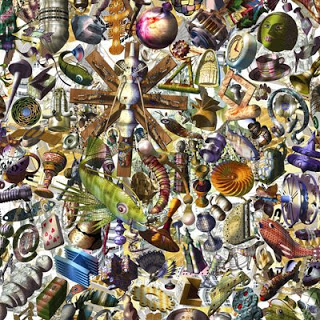John Hurrell – 3 June, 2009
The title of this show is apt. It points to the visceral side effects of emotions, almost a pre-linguistic state where sensations from images and the relationships between them acquire their own power.
Ten Ivan Anthony artists here present sixteen works for our thoughtful deliberations - in the ‘office’ part of the gallery to the left of the top of the stairs. While some of the items have been exhibited before there is enough new work here to make this show an exciting display to spend some serious time with.
In Anthony’s office, a tiny Matt Hunt matchbox-sized painting faces two recent, considerably larger, Richard Killeen ink-jet works on the opposite wall. Killeen’s printed objects and creatures are so dense in illusory space and patterned planar surfaces that looking at them is like using a knife to cut one of those super rich Italian cakes jammed with nuts and fruit. It requires considerable ability to optically navigate around all the detail embedded in the wildlife floating before us. The air is thick with suspended fauna and intricate playthings, so much so that the composition seems holistic, without a dominant structure behind the placement of elements.
One surprise is a Roger Mortimer painting showing a plane flying low over (or within) a sea which doubles as topographical map. It is like a varnished over transfer, with a delicate, brown, brittle quality, and similar to a child’s encyclopaedia illustration with lots of unexpected detail. There are also incongruous additions - like the plane’s shadow turning into a bending hammerhead shark, or an underwater pheasant.
The title of this show is apt. It points to the visceral side effects of emotions, almost a pre-linguistic state where sensations from images and the relationships between them acquire their own power. A small Michael Harrison acrylic on paper carries the subtlest, yet most effective of punches: a delicate stalk of bamboo leaves hovering above four rocks in a pool, its downward spikey tips foils to their heavy undulating curves.
There is a sense of piercing stillness in the Harrison that mentally moves, yet the Saskia Leek in the adjacent room, of a rocklike cubist formation, is also riveting. In odd contrast to the static Harrison, Leek’s superbly constructed image seems a fragmented mound at full gallop - a sprinting tanklike animal.
Dior, the Yvonne Todd portrait, shows an immaculately tailored and impeccably made up young woman with long tousled and unruly hair. That aspect is slightly unnerving - something uncanny and disorienting - a detail that dominates the image so that (unusual for a fetish substance) its tangledness takes on an independence. It seems disembodied, with emotional properties that lash out against ‘correct’ grooming. Hair that is ‘angry’.
Brendon Wilkinson’s mauve watercolour of death taunting a beautiful young woman intrigues with an inventive synthesis of fragmented skull parts, cobweb, necklace and tassels. Its drama is a cleverly placed foil to the superbly drawn Francis Upritchard dancing girl (a hand coloured lithograph) in the hallway, an image like the Harrison mentioned earlier that is calming and serene. Her languid arms and meticulous hands have an ancient Egyptian profile that offsets a peculiar but haunting impassive gaze, and implied but invisible coloured veil.
John Hurrell






 Advertising in this column
Advertising in this column Two Rooms presents a program of residencies and projects
Two Rooms presents a program of residencies and projects



This Discussion has 0 comments.
Comment
Participate
Register to Participate.
Sign in
Sign in to an existing account.